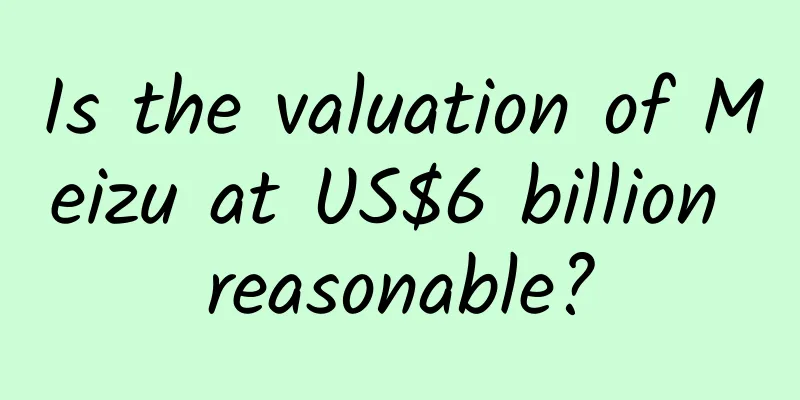Is the valuation of Meizu at US$6 billion reasonable?

|
It is well known that Meizu has fully learned Xiaomi's business model, and now, Meizu even plans to follow Xiaomi's valuation. In a recent interview, Meizu Vice President Li Nan said that if calculated by Xiaomi's P/E ratio, Meizu's valuation would be about $6 billion, and he also talked about Meizu's plan to IPO before Xiaomi. This valuation is naturally quite different from Xiaomi's $40 billion, but you have to know that Xiaomi has made extensive layouts in the Internet field and smart hardware ecology, which can be said to be a sufficient concept. In addition, Xiaomi's low-end smartphones have also reached a certain scale in domestic sales, so that IDC and other research institutions ranked Xiaomi's mobile phone shipments in the third quarter of this year as the third in the world. Therefore, it is understandable that some investors think that Xiaomi has considerable commercial imagination, although Toutiao does not agree (the specific reasons will be explained in detail later). However, the situation of Meizu cannot be compared with that of Xiaomi. Regardless of whether Xiaomi's current valuation is worth $40 billion, and whether Meizu's valuation based on Xiaomi is reasonable, the fact that Meizu's valuation is close to half of Lenovo's (the largest domestic hardware device manufacturer) market value (measured by Lenovo's current market value of about $15.6 billion) is enough to trigger Toutiao's doubts: Can a hardware company that mainly makes profits by selling smartphones, as long as it starts to learn Xiaomi's "triathlon" gameplay and calls itself a "table rider", get a valuation far higher than its own strength? Revenue is only 1/33 of Lenovo's In Toutiao's opinion, no matter how rich the business concept is or how vast the business imagination space is, if an enterprise estimates its capital value, it should first look at the enterprise's revenue level and net profit margin. In terms of revenue scale, according to relevant reports, Xiaomi's revenue in 2013 more than doubled year-on-year to RMB 27 billion, and is expected to exceed RMB 80 billion in 2014. According to Li Nan, vice president of Meizu, Meizu shipped about 2 million units in 2013, with a revenue of RMB 5 billion. In 2014, it is expected to ship 4-5 million units, with a revenue target of more than RMB 7 billion. Just from the revenue comparison between Meizu and Xiaomi, the gap between Meizu and Xiaomi is nearly 10 times. According to relevant reports, 94% of Xiaomi's current profits come from mobile phone sales. Although Meizu has not released official profit data, considering that Meizu currently only has two core businesses, Flyme system UI and Meizu mobile phones, if Meizu has any profit, then most of its profits should also come from mobile phone sales. In other words, in terms of revenue and profit level alone, the gap between Meizu and Xiaomi is as much as 10 times. Compared with Lenovo, Lenovo's revenue in just one quarter this year reached 10.395 billion US dollars, while last year's revenue was 38.7 billion US dollars. Even if Meizu's revenue this year can reach 7 billion yuan (remember it is RMB, not US dollars), it is only about 1/33 of Lenovo's at best, of course, this is not counting Lenovo's acquisition of IBM's X86 server business and Motorola's mobile business (both acquisitions have been announced to be completed). As for profits, since Meizu has not announced them, we cannot make an effective comparison, but we know that Lenovo's net profit last year was 817 million US dollars, and the net profit in the latest quarter this year was 214 million US dollars. It can be said that Meizu, whose profit model is still relatively simple, has a valuation close to half of Lenovo's, which can be said to violate the most basic laws and rules of business and capital. The annual sales volume is less than one-third of Xiaomi's first quarter sales volume. Secondly, the business scale. Xiaomi shipped 18.4 million smartphones in the third quarter of this year. Except for a few overseas emerging markets, most of them were sold domestically. How about Meizu's smartphone sales? As mentioned above, the estimated shipment volume in 2014 is 4-5 million units. In other words, Meizu's annual smartphone sales are about one-third of Xiaomi's sales in one quarter. If we compare it with Lenovo, I can’t bear to continue the comparison. I will just say one thing: Lenovo not only firmly occupies the leading position in the traditional PC industry, but also ranks among the top five in the mobile Internet industry represented by smartphones and tablets. In comparison, Meizu only has smartphones as its main business. The gap between its business scale and Lenovo cannot be described as “far away”, but I am at a loss for words. Expanding scale and revenue is the top priority In addition to the above-mentioned gap in revenue capacity and main business scale (volume), let's look at whether Meizu's valuation is reasonable from the perspective of competition in the mobile phone industry. This time, Toutiao will not bring Lenovo into the picture... The picture is so tragic that even Toutiao dare not look at it for too long... Like Xiaomi, Meizu’s current business is the core of its smartphone industry. However, from the development trend of the entire smartphone industry, the slowdown in growth and the low-priced phones have become the driving force for development. In addition, the “Xiaomi model” has been imitated by competitors. The competition faced by Xiaomi and its imitators (such as Meizu) in the industry will only become more and more fierce. In the future, they will face the choice of scale and profit: either high profit margins or scale in exchange for profits. At least for now, apart from Apple, few hardware equipment companies can survive and develop with high profit margins. The most feasible way is to increase total profits through scale. Therefore, since Xiaomi released the low-priced Redmi series of mobile phones to replace Xiaomi mobile phones as the main shipment, Xiaomi has actually embarked on a large-scale business model. In other words, for Xiaomi and Meizu, the sales of low-end mobile phones in the future will be crucial. Because of this, Xiaomi has been high-profile in its overseas market layout with the Redmi series of mobile phones since this year. Faced with the huge overseas market of 1 billion replacements, Xiaomi's strategic layout of entering emerging markets such as India and Brazil is a natural thing to do. But the problem is that domestic hardware manufacturers such as Lenovo and Huawei, which also covet the overseas market, have great advantages in supply chain and channels, but Xiaomi is currently at a disadvantage in areas that may be crucial to future smartphone competition, such as overall scale, global layout, channel operator relations, and intellectual property accumulation, and these shortcomings cannot be made up overnight. Similarly, Meizu lacks the above problems more than Xiaomi. At present, in addition to relying on MX4 Pro to seek the possibility of breaking through the 2,000 yuan price range, Meizu also urgently needs to make efforts in the low-end market below 1,000 yuan, and achieve the goal of reducing costs by building a certain supply chain advantage through volume. According to Li Nan, Meizu wants to make a 1,000 yuan phone with a better experience than Redmi and Honor, and it is expected to be released in early 2015. Obviously, how to expand shipments and revenue, a matter of life and death for a hardware equipment company, is much more important than valuation and listing. Survival is still Meizu's top priority. Is the “table-riding faction” really reliable? Finally, let’s talk about the essence of the Xiaomi model, and whether the valuations of Xiaomi and Meizu are reliable from the perspective of the business value of the “table-riding party”? What is the inherent business logic of the Xiaomi model? Toutiao believes that if Xiaomi is simply compared with hardware companies such as Samsung, Lenovo, and Huawei, it is difficult to see Xiaomi's "ambition". Because although Xiaomi is "riding on the table" and focusing on the business card of combining software and hardware, from Lei Jun's series of layouts and plans, Xiaomi hopes to establish a certain competitive advantage or barrier on the Internet service side, that is, Xiaomi hopes to make a fuss around users to obtain traffic entrance-style monopoly profits. In this regard, Xiaomi not only wants to be Tencent, providing users with Internet value-added services such as information, application distribution, games, audio-visual, and reading, but also wants to be Alibaba, providing related services around users' needs in life, entertainment, and shopping. In other words, if Xiaomi wants to achieve real success, it must win three major battles: the battle of Internet entrances, the battle of mobile payments, and the battle of virtual content. The opponents can be the BAT Big Three, or international giants such as Apple, Google, and Microsoft... In short, Toutiao just wants to wish Xiaomi good luck. Meizu's "ambition" is not that big at the moment. From Li Nan's words, we know that Meizu's future positioning for the company is to become a mobile phone company that survives the global mobile phone industry reshuffle, maintains the tradition and characteristics of Meizu products, takes into account both mobile phone shipments and brands, and maintains high user retention. In other words, Meizu temporarily only wants to support the Meizu software and hardware ecosystem through product strategy and channel strategy. If it can form a certain strong entrance and traffic revenue in software and Internet services such as application and game distribution, it will be very good. As for the all-out war in the mobile Internet field, Meizu is currently not able to participate. The so-called ecological layout may only be concept-first and go with the flow. Therefore, for Meizu and Xiaomi, the ideal is "full" but the reality is "skinny". Before completing the above-mentioned ecological layout and forming competitive barriers, Xiaomi, which combines software and hardware, must first survive as a mobile phone company like Apple. What is more critical is that software and Internet services should provide good experience and functions on every device and system platform as much as possible, which is almost a completely open ecosystem. This is exactly contrary to the business model that focuses on hardware device services: a company that relies on selling hardware devices as its main profit model must provide a closed ecosystem. This contradiction and conflict at the business model level will be the common fate that every "table rider" must face. As a winner of Toutiao's Qingyun Plan and Baijiahao's Bai+ Plan, the 2019 Baidu Digital Author of the Year, the Baijiahao's Most Popular Author in the Technology Field, the 2019 Sogou Technology and Culture Author, and the 2021 Baijiahao Quarterly Influential Creator, he has won many awards, including the 2013 Sohu Best Industry Media Person, the 2015 China New Media Entrepreneurship Competition Beijing Third Place, the 2015 Guangmang Experience Award, the 2015 China New Media Entrepreneurship Competition Finals Third Place, and the 2018 Baidu Dynamic Annual Powerful Celebrity. |
<<: Xiaomi-style "sense of participation" is not something that everyone can afford
>>: How do mobile phone users become crazy fans?
Recommend
Snack industry Douyin self-broadcast promotion strategy
During this year’s Double 11, many leading snack ...
Is the Earth getting crooked? This may be because humans are over-extracting groundwater
Produced by: Science Popularization China Author:...
In the live streaming melee, will the five major camps of YY, Yingke, Momo, KK and Douyu be formed soon?
With the rise of internet celebrities such as Pap...
Electric Technology Car News: When the younger generation leads the trend, Changan is going against the trend. Can the gradually mature Ford EcoSport successfully take the lead?
If you own a small SUV, what do you want from it?...
Why do users dislike ads? There are 5 factors
Let's get straight to the point. The five fac...
What details should be paid attention to in SEM bidding?
Detail 1: Keyword accuracy. The core theme of SEM...
The beginning of China's artificial intelligence is closely related to this mathematician
Wu Wenjun at work (May 12, 1919 - May 7, 2017). I...
World Economic Forum: Unlocking the Social Economy
The World Economic Forum has published “Unlocking...
How to use Toutiao's recommendation rules to create a hit article with over 1 million readers? (10,000 words of dry goods)
Toutiao has been able to become a disruptor in th...
To NetEase: Why is it that Tang Yan is only being paid today after leaving the company for so long?
This morning, NetEase chose to issue a statement ...
How do iPhone and Android phones receive push notifications?
How do we receive push notifications on our phone...
Can eating garlic regularly lower blood pressure? Doctor: If you want to stabilize your blood pressure, you really should eat less of these 3 types of food
Reviewer of this article: Chen Haixu, Deputy Dire...
Why is the volume dropping? Five factors that make APP promotion difficult!
Many CP friends who do channel (especially third-p...
How to build a user incentive system to enhance stickiness?
When making an app, we know that if users have li...
Android development, learning resources you should know
[[133537]] 1. Foreign tutorial websites Android D...









